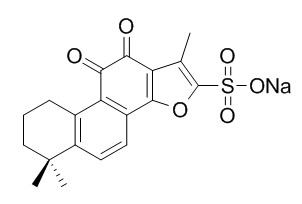Sulfotanshinone IIA Sodium
Sulfotanshinone IIA Sodium protects peritoneal mesothelial cells against PDS-induced oxidative injury through suppression of ASK1-p38 signaling.
Inquire / Order:
manager@chemfaces.com
Technical Inquiries:
service@chemfaces.com
Tel:
+86-27-84237783
Fax:
+86-27-84254680
Address:
1 Building, No. 83, CheCheng Rd., Wuhan Economic and Technological Development Zone, Wuhan, Hubei 430056, PRC
Providing storage is as stated on the product vial and the vial is kept tightly sealed, the product can be stored for up to
24 months(2-8C).
Wherever possible, you should prepare and use solutions on the same day. However, if you need to make up stock solutions in advance, we recommend that you store the solution as aliquots in tightly sealed vials at -20C. Generally, these will be useable for up to two weeks. Before use, and prior to opening the vial we recommend that you allow your product to equilibrate to room temperature for at least 1 hour.
Need more advice on solubility, usage and handling? Please email to: service@chemfaces.com
The packaging of the product may have turned upside down during transportation, resulting in the natural compounds adhering to the neck or cap of the vial. take the vial out of its packaging and gently shake to let the compounds fall to the bottom of the vial. for liquid products, centrifuge at 200-500 RPM to gather the liquid at the bottom of the vial. try to avoid loss or contamination during handling.
Cell J.2024, 26(8):496-504.
Mol Immunol. 2016, 78:121-132
Auburn University2015, 1-58
J Med Assoc Thai2024, P-04.
Mol Biol Rep.2022, doi: 10.1007
Kor. J. Herbol.2019, 34(2):59-66
Asian J Beauty Cosmetol2020, 18(3): 265-272.
Molecules.2019, 24(12):E2286
New Journal of Chemistry2019, 43:12538-12547
BMC Complement Med Ther. 2020, 20(1):91.
Related and Featured Products
Cellular Physiology & Biochemistry, 2018:2434-2444.
Sulfotanshinone IIA Sodium Ameliorates Glucose Peritoneal Dialysis Solution-Induced Human Peritoneal Mesothelial Cell Injury via Suppression of ASK1-P38-mediated Oxidative Stress.[Reference:
WebLink]
Long-term use of high-glucose peritoneal dialysis solution (PDS) induces peritoneal mesothelial cell (PMC) injury, peritoneal dysfunction, and peritoneal dialysis (PD) failure in patients with end-stage renal disease. How to preserve PMCs in PD is a major challenge for nephrologists worldwide. In this study, we aimed to elucidate the efficacy and mechanisms of Sulfotanshinone IIA Sodium (Tan IIa) in ameliorating high-glucose PDS-induced human PMC injury.
METHODS AND RESULTS:
The human PMC line HMrSV5 was incubated with 4.25% PDS in vitro to mimic the high-glucose conditions in PD. Cellular viability was measured by Cell Counting Kit 8. Generation of superoxide and reactive oxygen species (ROS) was assessed using a Total ROS/Superoxide Detection Kit. Oxidative modification of protein was evaluated by OxyBlot Protein Oxidation Detection Kit. TUNEL (dT-mediated dUTP nick end labeling) assay and DAPI (4,6-diamidino-2-phenylindole) staining were used to evaluate apoptosis. Western blot analysis was performed to evaluate the efficacy and mechanisms of Tan IIa. Tan IIa protected PMCs against PDS-induced injury as evidenced by alleviating changes in morphology and loss of cell viability. Consistent with their antioxidant properties, N-acetyl-L-cysteine (NAC) and Tan IIa suppressed superoxide and ROS production, protein oxidation, and apoptosis elicited by PDS. Apoptosis signal-regulating kinase 1 (ASK1)-p38 signaling was activated by PDS. Both Tan IIa and NAC suppressed ASK1 and p38 phosphorylation elicited by PDS. Moreover, genetic downregulation of ASK1 ameliorated cell injury and inhibited the phosphorylation of p38 and activation of caspase 3.
CONCLUSIONS:
Tan IIa protects PMCs against PDS-induced oxidative injury through suppression of ASK1-p38 signaling.



